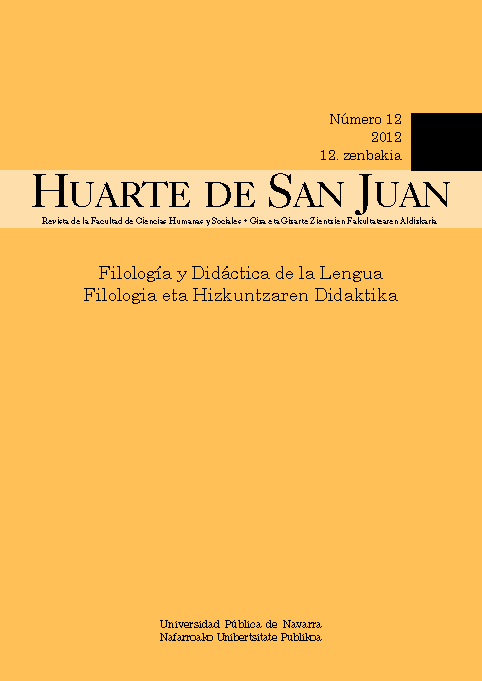Motivación en el aprendizaje de lenguas: estado de la cuestión
Palabras clave:
Motivación, enseñanza lenguas, perspectivas actualesResumen
Este artículo revisa los distintos enfoques que se han adoptado en la investigación de la motivación en el contexto del aprendizaje de lenguas desde mediados del siglo pasado hasta nuestros días. Partiendo de una perspectiva psicológico-social, nos centramos después en una perspectiva cognitiva y finalmente se presentan enfoques más actuales que consideran la motivación como algo cualitativamente específico de cada aprendiz de lenguas.
Descargas
Citas
Brown, H.D. (1994): Teaching by principles. Eaglewood Cliffs, NJ: Prentice Hall.
Brown, H.D. (2000): Principle of language learning and teaching. New York: Longman.
Clément, R. (1980): “Ethnicity, contact and communicative competence in a second language”, en Giles, H., Robinson, W.P. y Smith, P.M. (eds.), Language: social psychological perspectives. Oxford: Pergamon, pp. 147-154.
Crookes, G. y Schmidt, R. (1991): “Motivation: Reopening the research agenda”, Language Learning, 41, 469-512.
Csizér, K. y Lukács, G. (2010): “The comparative analysis of motivation, attitudes and selves: The case of English and German in Hungary”, System, 38, 1-13.
Deci, E.L. (1992): “The relation of interest to the motivation of behavior: A Self-determination Theory perspective”, en K.A. Renninger, S. Hidi, S. y A. Krapp (eds.), The role of interest in language and development. Hillsdale, NJ: Erlbaum, pp. 43-70.
Dörnyei, Z. (1994): “Motivation and motivating in the foreign language classroom”, The Modern Language Journal, 78, 273-284.
Dörnyei, Z. (2001): Teaching and researching motivation. Harlow: Longman.
Dörnyei, Z. (2005): The psychology of the language learner: individual differences in second language acquisition. Mahwah, NJ: Erlbaum.
Dörnyei, Z. (2009): “The L2 Motivational Self-System”, en Z. Dörnyei y E. Ushioda (Eds), Motivation, language identity and the L2 self. Bristol: Multilingual Matters, pp. 9-42.
Dörnyei, Z. y Csizér, K. (2002): “Motivational dynamics in second language acquisition: Results of a longitudinal nationwide survey”, Applied Linguistics, 23, 421-462.
Dörnyei, Z. y Otto, I. (1998): “Motivation in action: A process of L2 motivation”, Working Papers in Applied Linguistics, 4, 43-69.
Eccles, J.S. y Wigfield, A. (1995): “In the mind of the actor: The structure of adolescents’ achievement task values and expectancy-related beliefs”, Personality and Social Psychology Bulletin, 21, 215-225.
Ehrman, M. (1996): “An exploration of adult language learner motivation, selfefficacy, and anxiety”, en Oxford, R.L. (ed.), Language learning motivation: Pathways to the new century. Honolulu, HI: University of Hawaii, pp. 81-102.
Gardner, R.C. (1985): Social psychology and second language learning: The roles of attitudes and motivation. London: Edward Arnold.
Gardner, R.C. (2006): “The socio-educational model of second language acquisition: a research paradigm”, EUROSLA Year book, 6, 237-260.
Gardner, R.C. y Lambert, W.E. (1972): Attitudes and motivation: Second language learning. Newbury House.
Gardner, R.C. y MacIntyre, P.D. (1991): “An instrumental motivation in language study: Who says it isn’t effective”, Studies in Second Language Acquisition, 13, 57-72.
Hiromori, T. (2009): “A process model of L2 learners’ motivation: From the perspectives of general tendency and individual differences”, System, 37, 313-321.
Markus, H.R. y Nurius, P. (1986): “Possible selves”, American Psychologist, 41, 954-969.
Noels, K.A., Pelletier, L.G., Clément, R. y Vallerand, R.J. (2000): “Why are you learning a second language? Motivational orientations and Self-Determination Theory”, Language Learning, 50, 57-85.
Nunan, D. (1999): Second language teaching and learning. Boston, MA: Heinle & Heinle.
Segal, H.G. (2006): “Possible selves, fantasy distortion, and the anticipated life history: Exploring the role of imagination in social cognition”, en C. Dunkel y J. Kerpelman (eds.) Possible Selves: Theory, Research and Applications. New York: Nova Science, pp. 79-96.
Schumann, J.H. (1986): “Research on the acculturation model for second language acquisition”, Journal of Multilingual and Multicultural Development, 7, 379-392.
Spolsky, B. (1988): “A general theory of second language learning”, TESOL Quarterly, 22, 377-396.
Tremblay, P.F. y Gardner, R.C. (1995): “Expanding the motivation construct in language learning”, The Modern Language Journal, 79, 505-518.
Ushioda, E. (1996): “Developing a dynamic concept of L2 motivation”, en T. Hickey y J. Williams (eds.), Language, education and society in a changing world. Dublin: IRAAL Multilingual Matters, pp. 239-245.
Ushioda, E. (2008): “Motivation and good language learners”, en C. Griffiths (ed.), Lessons from Good Language Learners. Cambridge: Cambridge University Press, pp.19-34.
Ushioda, E. (2009): “A person-in-context relational view of emergent motivation, self and identity”, en Z. Dörnyei y E. Ushioda (eds.), Motivation, language identity and the L2 self. Bristol: Multilingual Matters, pp. 215-228.
Van Lier, L. (1996): Interaction in the Language Curriculum: Awareness, Autonomy and Authenticity. Harlow: Longman.
Williams, M. y Burden, R. (1997): Psychology for language teachers. Cambridge: Cambridge University Press.
Descargas
Publicado
Cómo citar
Número
Sección
Licencia
Todos los artículos son publicados bajo una licencia de uso y distribución Creative Commons (BY-NC-ND 4.0). A cada artículo se le asignará un identificador DOI.
Los autores conservan los derechos de autor y conceden a la revista el derecho de la primera publicación. Los autores podrán establecer acuerdos adicionales para la distribución no exclusiva de la versión de la obra publicada en la revista (por ejemplo, situarlo en un repositorio institucional), con un reconocimiento de su publicación inicial en esta revista. Los trabajos podrán subirse a repositorios institucionales inmediatamente tras la publicación de la revista.
Asimismo, se permite y se anima a los autores a difundir sus trabajos electrónicamente (por ejemplo, en repositorios institucionales, redes sociales académicas o en su propio sitio web).







